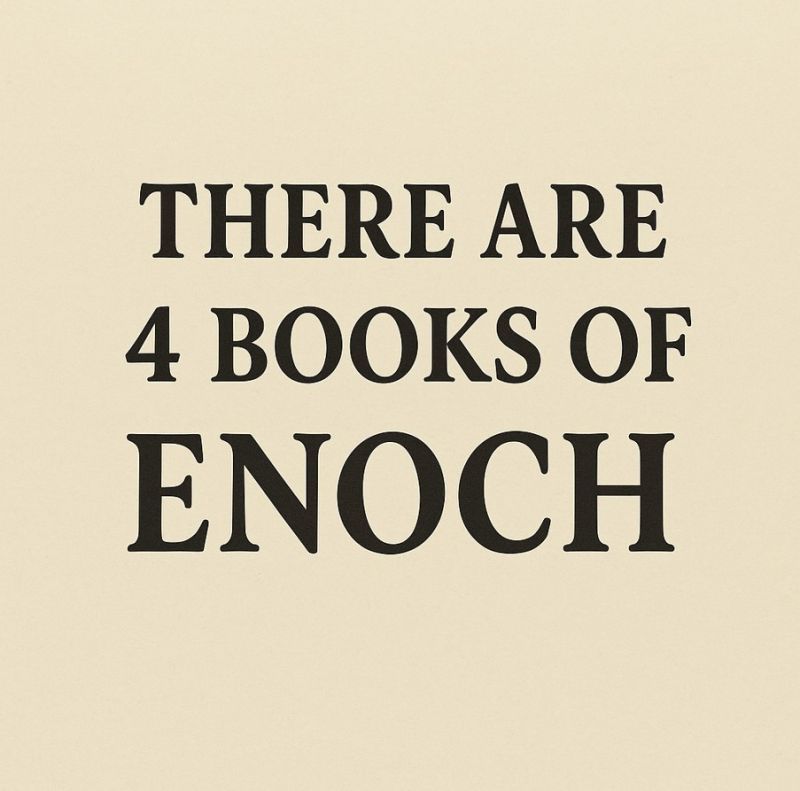There are multiple "Books of Enoch", and it's essential to distinguish among them. When people refer to "The Book of Enoch" today, they usually mean 1 Enoch (Ethiopic Enoch). The others are 2 Enoch (Slavonic Enoch), 3 Enoch (Hebrew Enoch), and sometimes 4 Enoch, a scholarly term for a lost or reconstructed text.
Below is a detailed breakdown of the four Books of Enoch, the types of data they present, and how accurate or speculative they are, with a focus on which sections match historical or theological consistency, and which deviate.
1 Enoch (Ethiopic Enoch) – Most cited, most influential
| Section | Content | Date | Notes |
|---|---|---|---|
| Book of the Watchers (Ch. 1–36) | Angels fall, Nephilim born, judgment declared | 300–200 BC | Expands Genesis 6 with elaborate angel-demon narratives |
| Astronomical Book (Ch. 72–82) | 364-day calendar, sun/moon paths | 200–190 BC | Reflects ancient cosmology; rejects lunar calendar |
| Book of Dream Visions (Ch. 83–90) | Animal symbolism of Israel’s history | 200–150 BC | Matches history up to Maccabean revolt allegorically |
| Epistle of Enoch (Ch. 91–108) | Judgment, reward of righteous, woes on sinners | 150–50 BC | Much resembles apocalyptic warnings of prophets and NT |
| Book of Parables (Ch. 37–71) | “Son of Man,” messianic figure, Final Judgment | 100–50 BC | Accurate in doctrine but may show Christian-era influence |
2 Enoch (Slavonic Enoch)–a.k.a. “Secrets of Enoch”
| Attribute | Details |
|---|---|
| Date | Late 1st century AD (possibly earlier), preserved in Old Church Slavonic |
| Content | Describes Enoch’s journey through 10 heavens, angelic orders, and creation |
| Accuracy | ❌ Cosmologically inaccurate – follows Hellenistic/gnostic-like cosmology |
| Value | Interesting for understanding mystical Judaism and early Christian-era thought |
| Discrepancies | No mention of Son of Man or Messianic age; strange angelology and physics |
📕3 Enoch (Hebrew Enoch)–a.k.a. “Sefer Hekhalot”
| Attribute | Details |
|---|---|
| Date | 5th–6th century AD |
| Content | Mystical ascent of Rabbi Ishmael, identifies Enoch as angel Metatron |
| Accuracy | ❌ Mystical/Kabbalistic; not historically grounded |
| Value | Preserves later Merkabah (chariot) mysticism and rabbinic angelology |
| Issues | Departs from biblical theology by elevating Enoch to near-divine angelic being |
📓4 Enoch–Modern scholarly term
| Attribute | Details |
|---|---|
| Nature | Not a distinct book, but a reconstruction of Jewish Enoch traditions |
| Used for | Analyzing how Enoch traditions evolved from Genesis to Revelation |
| Contains | Traces from Jubilees, Genesis Apocryphon, Enochic fragments, NT epistles |
| Accuracy | ⚠️ Depends on source |
🎯 Summary Table
| Book | Timeframe | Theology | Science/Cosmology | Notes |
|---|---|---|---|---|
| 1 Enoch | 300–50 BC | ✅ Mostly consistent with Scripture (esp. judgment, Son of Man) | ❌ different calendar | Most quoted; Jude references it |
| 2 Enoch | ~1st century AD | ⚠️ Mystical, semi-gnostic | ❌ 10 heavens, strange creation | Less influence, preserved in Slavonic |
| 3 Enoch | 5th–6th century AD | ❌ Kabbalistic, borderline heretical | ❌ Metatron theology | Not referenced by NT writers |
| 4 Enoch | N/A | N/A | N/A | Scholarly concept, not a real book |
✅ Which Book Is Most "Accurate"?
-
1 Enoch is the only version with:
-
Early Jewish roots
-
Verified fragments from Qumran (Dead Sea Scrolls)
-
Influence on the New Testament
-
-
Within 1 Enoch, the Epistle of Enoch and Book of Dream Visions are the most theologically solid.
-
The Book of Watchers and Astronomical Book are mythical and pseudoscientific.
